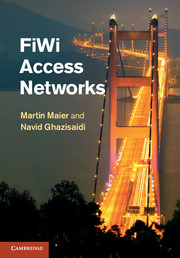Book contents
- Frontmatter
- Contents
- List of figures
- List of tables
- Preface
- Acknowledgments
- Part I Introduction
- Part II Fiber access networks
- Part III Wireless access networks
- Part IV FiWi access networks
- 10 RoF vs. R&F networks
- 11 Architectures
- 12 Network planning and reconfiguration
- 13 Techno-economic analysis
- 14 Network coding
- 15 Optical and wireless protection
- 16 Hierarchical frame aggregation
- 17 Routing and QoS continuity
- 18 Smart grid communications
- References
- Index
10 - RoF vs. R&F networks
from Part IV - FiWi access networks
Published online by Cambridge University Press: 05 January 2012
- Frontmatter
- Contents
- List of figures
- List of tables
- Preface
- Acknowledgments
- Part I Introduction
- Part II Fiber access networks
- Part III Wireless access networks
- Part IV FiWi access networks
- 10 RoF vs. R&F networks
- 11 Architectures
- 12 Network planning and reconfiguration
- 13 Techno-economic analysis
- 14 Network coding
- 15 Optical and wireless protection
- 16 Hierarchical frame aggregation
- 17 Routing and QoS continuity
- 18 Smart grid communications
- References
- Index
Summary
Radio-over-fiber (RoF) networks have been studied for many years as an approach to integrating optical fiber and wireless networks. In RoF networks, radio frequencies (RFs) are carried over optical fiber links between a central station and multiple low-cost remote antenna units (RAUs) in support of a variety of wireless applications. For instance, a distributed antenna system connected to the base station of a microcellular radio system via optical fibers was proposed in (Chu and Gans [1991]). To efficiently support time-varying traffic between the central station and its attached base stations, a centralized dynamic channel assignment method is applied at the central station of the proposed fiber optic microcellular radio system. To avoid having to equip each radio port in a fiber optic microcellular radio network with a laser and its associated circuit to control the laser parameters such as temperature, output power, and linearity, a cost-effective radio port architecture deploying remote modulation may be used (Wu et al. [1994]).
Apart from realizing low-cost microcellular radio networks, optical fibers can also be used to support a wide variety of other radio signals. RoF networks are attractive since they provide transparency against modulation techniques and are able to support various digital formats and wireless standards in a cost-effective manner. It was experimentally demonstrated in (Tang et al. [2004]) that RoF networks are well suited to simultaneously transmit wideband code division multiple access (WCDMA), IEEE 802.11a/g wireless local area network (WLAN), personal handyphone system (PHS), and global system for mobile communications (GSM) signals.
- Type
- Chapter
- Information
- FiWi Access Networks , pp. 117 - 126Publisher: Cambridge University PressPrint publication year: 2011



